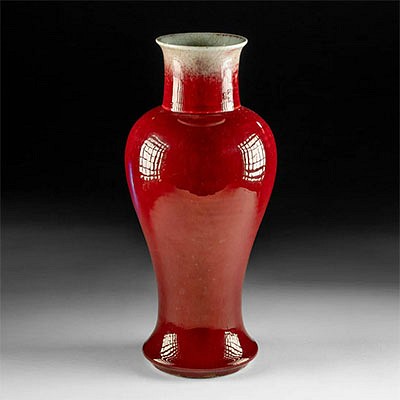Viking Jelling Gilt Silver Brooch w/ Gripping Beast
Lot 80
About Seller
Artemis Gallery
686 S Taylor Ave, Ste 106
Louisville, CO 80027
United States
Selling antiquities, ancient and ethnographic art online since 1993, Artemis Gallery specializes in Classical Antiquities (Egyptian, Greek, Roman, Near Eastern), Asian, Pre-Columbian, African / Tribal / Oceanographic art. Our extensive inventory includes pottery, stone, metal, wood, glass and textil...Read more
Estimate:
$7,000 - $10,500
Absentee vs Live bid
Two ways to bid:
- Leave a max absentee bid and the platform will bid on your behalf up to your maximum bid during the live auction.
- Bid live during the auction and your bids will be submitted real-time to the auctioneer.
Bid Increments
| Price | Bid Increment |
|---|---|
| $0 | $25 |
| $300 | $50 |
| $1,000 | $100 |
| $2,000 | $250 |
| $5,000 | $500 |
| $10,000 | $1,000 |
| $20,000 | $2,500 |
| $50,000 | $5,000 |
| $100,000 | $10,000 |
| $200,000 | $20,000 |
About Auction
By Artemis Gallery
May 11, 2023
Set Reminder
2023-05-11 10:00:00
2023-05-11 10:00:00
America/New_York
Bidsquare
Bidsquare : Fine Antiquities, Asian, Pre-Columbian, Ethnographic Art
https://www.bidsquare.com/auctions/artemis-gallery/fine-antiquities-asian-pre-columbian-ethnographic-art-12771
Classical antiquities, ancient and ethnographic art from cultures encompassing the globe. Artemis Gallery info@artemisgallery.com
Classical antiquities, ancient and ethnographic art from cultures encompassing the globe. Artemis Gallery info@artemisgallery.com
- Lot Description
**Originally Listed At $4000**
Northern Europe, Scandinavia, Viking or Norse culture, ca. 9th to 11th century CE. A beautiful 65% to 98.6% silver brooch or belt buckle of rounded rectangular form exhibiting an abstract zoomorphic creature known as a "gripping beast," so called because its enormous serpentine legs are shown to wrap around whatever is in reach and 'grip' it so it cannot escape. The left-facing creature is shown 'standing' atop its tentacle-form limbs, each wrapping around a pair of abstract snakes shown intertwined within the scene. The gripping beast itself features incised swirls above its thighs, stacked stripes down the lower legs, and linear as well as stippled motifs on the neck. The entire obverse side is covered in a lustrous layer of gilding with scattered areas of the verso being covered in gilding as well. Size: 3.1" W x 2.68" H (7.9 cm x 6.8 cm); silver quality: 65% to 98.6%; gold quality: 33.45%; total weight: 107.1 grams
This is an incredible piece of wearable artwork and displayed wealth, which in the volatile Viking period often manifested in the form of jewelry made from precious metals, this necklace would have belonged to one of the most elite members of society.
The Jellinge Style (ca. 880 to 1000 CE) refers to a genre of ancient Scandinavian animal art that features stylized zoomorphic forms. Its name is derived from a small cup that was discovered in a royal burial mound at Jellinge, Denmark which was believed to be the burial place of King Gorm. This cup was decorated with S-shaped animals possessing profiled heads, ribbon-like bodies, spiral hips, and curled upper lips.
The important Viking metalworking shops correspond to their great trading ports and proto-urban centers - Birka, Helgo, Sigtuna, and Lund in Sweden, Ribe, Haithabu (Hedeby), and Fyrkat in Denmark, and Kaupang and Trondheim in Norway. Silver was the principal currency of the Viking world, which stretched from Russia to northern Canada at the height of their influence. In many places, the Vikings kept silver not as coins, but as jewelry, a wearable currency form that was not subject to the authority of a monarch or mint. One of the most common archaeological finds from the Viking period is a hoard of metal objects, often buried in the earth or deposited in bodies of water, like river beds.
PLEASE NOTE: Due to recent increases of shipments being seized by Australian & German customs (even for items with pre-UNESCO provenance), we will no longer ship most antiquities and ancient Chinese art to Australia & Germany. For categories of items that are acceptable to ship to Australia or Germany, please contact us directly or work with your local customs brokerage firm.
Provenance: private New York, New York, USA collection; ex-private Kaliningrad (Koenigsberg) and then Latvia collection; found on the Baltic Sea coast prior to 1982
All items legal to buy/sell under U.S. Statute covering cultural patrimony Code 2600, CHAPTER 14, and are guaranteed to be as described or your money back.
A Certificate of Authenticity will accompany all winning bids.
We ship worldwide and handle all shipping in-house for your convenience.
#176890Professionally cleaned across all surfaces. Minor abrasions to openwork decorations and surfaces, with light pitting in scattered areas, slight bending to overall form of buckle and pin, otherwise intact and excellent. Wonderful preservation to gripping beast and gilding in most areas. Pin on verso still articulates smoothly.Condition
- Shipping Info
-
All shipping is handled in-house for your convenience. Your invoice from Artemis Gallery will include shipping calculation instructions. If in doubt, please inquire BEFORE bidding for estimated shipping costs for individual items. In most cases Artemis Gallery cannot ship to Australia and Germany, please inquire before bidding.
-
- Buyer's Premium



 EUR
EUR CAD
CAD AUD
AUD GBP
GBP MXN
MXN HKD
HKD CNY
CNY MYR
MYR SEK
SEK SGD
SGD CHF
CHF THB
THB














